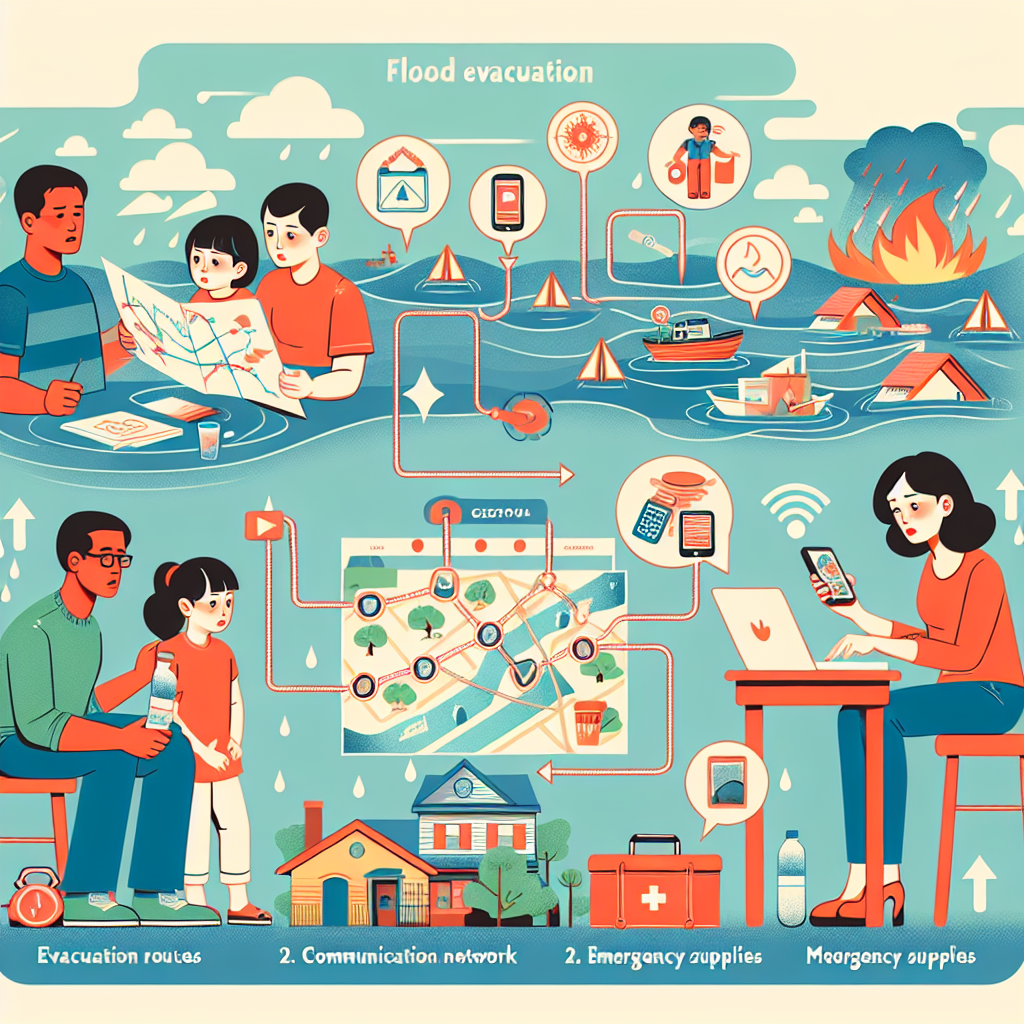Imagine living in a picturesque town where the serenity of nature surrounds you every day. However, this idyllic setting can quickly turn into a nightmare when heavy rainfall leads to a devastating flood. In such a situation, having a well-thought-out and efficient Flood Evacuation Plan becomes vital. This article explores the importance of being prepared for flooding emergencies and highlights the key elements required to ensure the safety and well-being of both individuals and communities.
Flood Evacuation Plan
A comprehensive flood evacuation plan is crucial in ensuring the safety and well-being of individuals in an area at risk of flooding. This article aims to provide you with a detailed guide on the development, implementation, and maintenance of a flood evacuation plan. By following the steps outlined below, you can be prepared for potential flooding and effectively mitigate the risks associated with it.

Development of a Flood Evacuation Plan
Developing a flood evacuation plan requires a collaborative effort between local authorities, emergency management agencies, and community stakeholders. The first step in this process is to assess the flood risks in your area. Gather information on historical flooding events, flood zones, and potential sources of flooding, such as rivers or coastal regions.
Once you have a clear understanding of the flood risks, establish a committee or task force responsible for creating the evacuation plan. This group should consist of individuals from various sectors, including emergency management, public safety, transportation, healthcare, and community representatives. Their expertise and diverse perspectives will ensure a well-rounded and effective evacuation plan.
Understanding Flood Risks and Warning Systems
To develop an efficient evacuation plan, it’s crucial to understand the flood risks specific to your area. This can be achieved by studying floodplain maps, consulting with local authorities, or utilizing online resources provided by government agencies.
In addition to identifying the flood risks, familiarize yourself with the warning systems in place. These systems include emergency alerts through mobile phones, sirens, and official announcements via radio or television. Understanding how these warning systems operate will enable you to respond promptly when a flood is imminent.
Creating an Emergency Response Team
A well-organized and trained emergency response team is essential for the successful execution of a flood evacuation plan. Identify individuals within your community or organization who are willing to take on leadership roles during emergencies. Establish clear responsibilities, such as managing evacuation centers, coordinating transportation, providing medical assistance, and ensuring communication.
Train the emergency response team on evacuation procedures, emergency first aid, and effective communication techniques. Regular exercises and drills should be conducted to ensure the team members are prepared and capable of handling any potential challenges that may arise during a flood evacuation.
Identifying Safe Locations and Shelters
Identifying safe locations and shelters is a critical component of any flood evacuation plan. Depending on the severity of the flood, some individuals may need to evacuate their homes while others may require temporary shelter until it is safe to return. Collaborate with local authorities to determine suitable locations for evacuation centers and shelters. Ensure that these facilities are equipped with necessary amenities, including food, water, medical supplies, and sanitation facilities.
Consider the unique needs of vulnerable populations within your community, such as the elderly, individuals with disabilities, or families with young children. Ensure that evacuation centers and shelters can accommodate their specific requirements and provide any necessary assistance.

Establishing Communication Channels
Open and effective communication is vital during a flood evacuation. Establish multiple communication channels to disseminate information and instructions to the community. Utilize various means such as social media, local radio, television, and emergency alert systems to reach as many people as possible.
It is crucial to maintain open lines of communication with key stakeholders, including local authorities, emergency management agencies, and community organizations. This will ensure coordination and cooperation throughout the evacuation process.
Evacuation Routes and Transportation
Identifying and mapping the most efficient evacuation routes is essential for a smooth and safe evacuation. Evaluate existing road networks and consider potential flood-prone areas that may present challenges during evacuations. Develop alternative routes to bypass these areas or establish emergency access points.
Coordinate with transportation providers, such as bus companies or other public transportation systems, to ensure their availability during evacuations. Plan for the transportation of individuals who do not have access to private vehicles, including those who require special assistance. Establish assembly points where individuals can gather to be safely transported to evacuation centers or shelters.

Preparing an Evacuation Kit
A well-stocked evacuation kit is crucial for each individual and family during a flood evacuation. Prepare an emergency kit that includes essential items such as non-perishable food, water, medications, first aid supplies, clothing, important documents, personal hygiene items, and a flashlight. Remember to consider the specific needs of family members, including infants, elderly individuals, and pets.
Regularly check and update your emergency kit to ensure it remains complete and supplies are not expired. Store the kit in an easily accessible location, known to all members of the household, in the event of a sudden evacuation.
Implementing the Evacuation Plan
When a flood is imminent or officially announced, it is time to implement the evacuation plan. Activate the emergency response team and ensure that all communication channels are operational. Initiate the evacuation process, providing clear instructions to the community on evacuation routes, assembly points, and available transportation options.
During the evacuation, monitor the progress and address any immediate issues or concerns that may arise. Adjust the plan if necessary and maintain open communication with evacuation centers and shelters to ensure a seamless transition for those seeking refuge.

Organizing Training and Drills
Regular training and drills are essential to the success of a flood evacuation plan. Conduct mock evacuations and exercises to test the efficiency of the plan, identify areas for improvement, and familiarize community members with the evacuation procedures. These drills will help build confidence, reduce panic, and ensure a quick response in the event of an actual flood.
Include various scenarios in the training sessions, such as sudden flash floods or extended flooding periods, to prepare individuals for different situations they may encounter. Evaluate the outcomes of the drills and make necessary adjustments to enhance the plan’s effectiveness and efficiency.
Post-Evacuation Strategies
The responsibilities of an effective flood evacuation plan do not end when individuals return to their homes. Develop post-evacuation strategies to support the recovery and well-being of the affected community. This may include providing psychological support services, conducting damage assessments, and coordinating with relevant agencies to facilitate the return of essential services, such as water and electricity.
Continue to engage with the community after the flood event, encouraging feedback and developing strategies to enhance future evacuation plans. Implement lessons learned from each flood evacuation to improve preparedness and response in subsequent events.
By following these guidelines, you can develop and implement a comprehensive flood evacuation plan that prioritizes the safety and well-being of individuals at risk of flooding. Remember, preparedness is key, and your efforts can make a significant difference in mitigating the impact of floods on your community. Stay informed, stay prepared, and stay safe!






